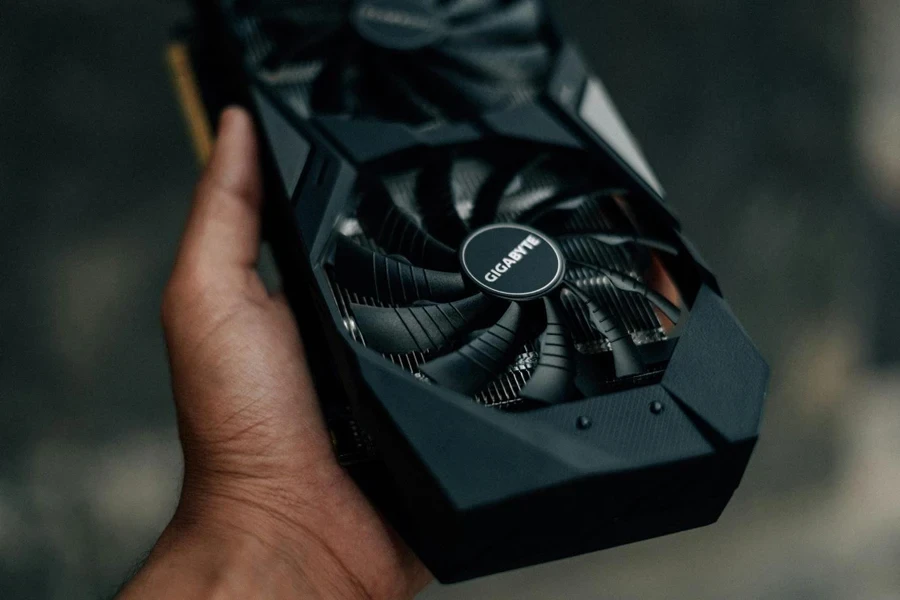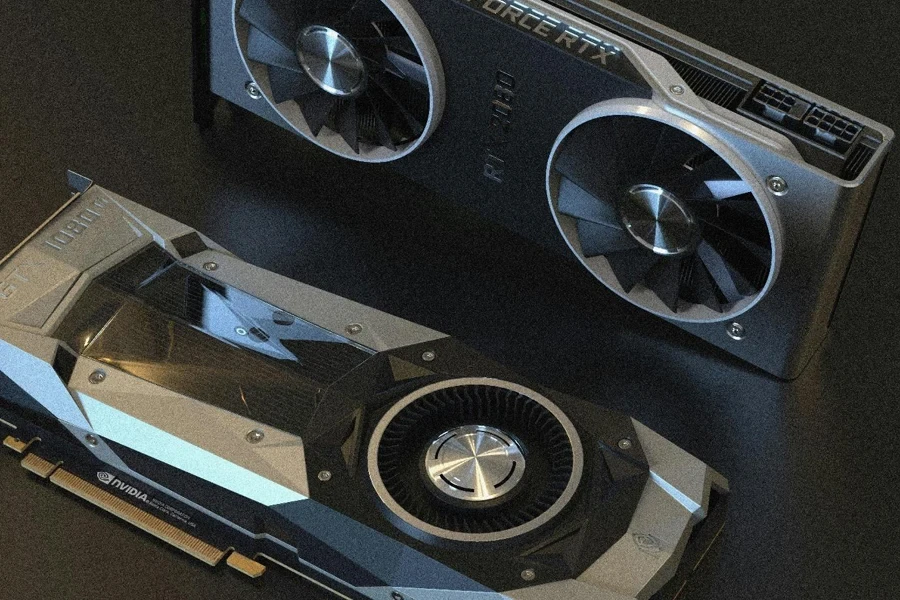In the fast-evolving world of graphics cards, staying ahead of market trends is essential for professional buyers seeking to make informed purchasing decisions. As the GPU market surges with innovations like AI acceleration and ray tracing, understanding these advancements and their impact on product performance is crucial.
This article delves into the latest market dynamics, highlighting key technologies and top-selling models that are shaping the industry. By exploring these trends, professionals can better navigate the complexities of the market and align their strategies with the most impactful developments. Informed decisions today will set the stage for future success in this competitive landscape.
Table of Contents
● Market overview
● Key technology and design innovations
● Top-selling models driving market trends
● Conclusion
Market overview

The GPU market’s unprecedented growth
The global GPU market is experiencing a significant surge, with the market valued at $65.3 billion in 2024 and projected to reach $274.2 billion by 2029, growing at a compound annual growth rate (CAGR) of 33.2%. This explosive growth is driven by the increasing demand for high-performance graphics in gaming, professional visualization, AI, and data centers. As more industries adopt GPU-accelerated technologies, the market continues to expand, positioning GPUs as a critical component in modern computing.
Shifting market dynamics and competitive landscape
The competitive landscape is also evolving, with companies like AMD, Nvidia, and Intel continually pushing the boundaries of performance and efficiency. Nvidia leads the market, particularly in segments like AI and high-end gaming, but AMD has gained significant ground with its cost-effective and powerful GPUs, such as the Radeon RX 7900 series.
Meanwhile, Intel’s entry into the discrete GPU market with its Arc series adds another layer of competition, particularly in the budget and mid-range segments. The shifting dynamics indicate a highly competitive market where innovation and strategic pricing will determine market shares in the coming years.
Key technology and design innovations

Ray tracing and realism: The next level of visual fidelity
Ray tracing has become a game-changer in the GPU industry, enabling more realistic rendering by simulating the physical behavior of light. This technique traces the paths of light rays as they interact with virtual objects, resulting in accurate reflections, refractions, and shadows. Modern GPUs, like those in Nvidia’s RTX series, incorporate dedicated RT cores to perform these complex calculations in real-time, drastically improving the visual fidelity in games.
For instance, the RTX 4090 can achieve up to 100% improved framerates in ray-traced games compared to previous models, making it a benchmark in high-performance gaming. Additionally, AMD’s RDNA 3 architecture has narrowed the performance gap, offering competitive ray tracing capabilities that deliver realistic lighting and shadow effects, even at 4K resolutions.
AI acceleration: Enhancing performance beyond gaming
AI acceleration is now integral to the performance of modern GPUs, with specialized cores designed to handle the intense computational demands of AI and machine learning tasks. Nvidia’s Tensor Cores, found in the RTX 40 series, utilize sparse matrix operations to accelerate AI workloads, such as deep learning inference and neural network training. These cores can deliver up to 4 times the performance in AI tasks compared to traditional GPU architectures. Similarly, AMD’s AI accelerators in the Radeon RX 7900 series are optimized for matrix multiplications, enabling faster AI computations that enhance both gaming experiences and professional workloads. These advancements are crucial not only for gaming but also for applications in fields like medical imaging and autonomous vehicles, where real-time AI processing is essential.

Miniaturization and efficiency: The future of compact power
The trend toward miniaturization in GPU design is driven by the need for high performance in increasingly compact and portable devices. Modern GPUs are being developed with advanced manufacturing processes, such as TSMC’s 5nm process technology, which allows for greater transistor density, leading to more powerful yet smaller chips. This miniaturization is complemented by improvements in power efficiency. For example, the Nvidia RTX 4070 Super operates with a TDP of just 220W, yet delivers performance comparable to older GPUs with much higher power requirements. These advancements are crucial for integrating GPUs into portable systems like laptops and small-form-factor desktops, where power consumption and heat dissipation are critical concerns. As a result, next-generation GPUs are expected to not only be smaller but also significantly more energy-efficient, making them suitable for a wider range of applications while reducing their environmental impact.
Top-selling models driving market trends

Midrange marvels: AMD Radeon RX 7900 GRE leads the pack
The AMD Radeon RX 7900 GRE has quickly established itself as a best-seller in the midrange GPU market, offering a compelling mix of performance and value. This model is equipped with 16GB of GDDR6 memory and operates with a 256-bit memory interface, making it ideal for gamers seeking high performance at 1440p resolutions. The RX 7900 GRE’s 300W power draw supports its robust performance, delivering over 20 TFLOPS of processing power, which allows it to handle demanding games with ease. Its popularity is further driven by its competitive pricing, which provides a cost-effective alternative to Nvidia’s offerings while still delivering top-tier gaming experiences.
Nvidia’s crown jewels: RTX 4070 Super and RTX 4080 Super
Nvidia’s RTX 4070 Super has become a top-selling model, particularly among gamers looking for a balance between price and performance. This GPU features 12GB of GDDR6X memory and a 2,475 MHz boost clock, offering impressive performance at both 1440p and 4K resolutions. The RTX 4070 Super is particularly known for its ray tracing capabilities, powered by 2nd generation RT cores that significantly enhance in-game lighting and shadow details. Additionally, the DLSS 3.0 feature boosts frame rates by using AI to generate additional frames, making it a preferred choice for gamers who prioritize both visual quality and smooth gameplay.
The RTX 4080 Super, another standout in Nvidia’s lineup, caters to enthusiasts seeking high-end performance without the premium price tag of the RTX 4090. With 16GB of GDDR6X memory and a 320W TDP, the RTX 4080 Super offers nearly 30 TFLOPS of processing power, making it a go-to option for 4K gaming. Its ability to handle real-time ray tracing and AI-enhanced graphics at ultra-high resolutions has made it a favorite among gamers who demand the best from their hardware.

Budget champions: AMD Radeon RX 7600 and Nvidia RTX 4060
For gamers on a budget, the AMD Radeon RX 7600 and Nvidia RTX 4060 are leading choices. The Radeon RX 7600, with its 8GB of GDDR6 memory and 165W TDP, provides excellent performance in 1080p gaming scenarios. Its architecture, built on RDNA 3, allows for efficient power consumption while still delivering strong performance, particularly in AAA titles. The RX 7600’s appeal lies in its ability to offer advanced features like FidelityFX Super Resolution at a price point accessible to a wider audience.
Similarly, the Nvidia RTX 4060 has carved out a niche as a budget-friendly option that doesn’t compromise on features. With 8GB of GDDR6 memory and a 128-bit memory bus, the RTX 4060 supports ray tracing and DLSS 3.0, making it a strong contender in the budget segment. It is designed to excel in 1080p and 1440p gaming, providing smooth performance even in graphically intensive games. The RTX 4060’s 115W TDP also makes it one of the more energy-efficient options on the market, further adding to its appeal for budget-conscious gamers.
Conclusion
The graphics card market is evolving rapidly, driven by significant technological advancements and shifting consumer preferences. With models like the AMD Radeon RX 7900 GRE and Nvidia RTX 4070 Super leading the way, the industry is set to continue its upward trajectory, offering powerful and efficient solutions across all segments. As businesses navigate this dynamic landscape, staying informed about these key developments will be essential for making strategic purchasing decisions that align with future trends.



